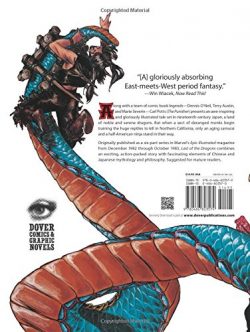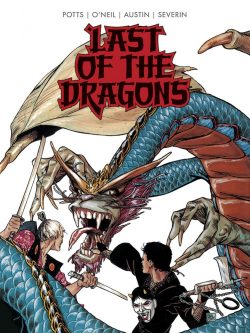

By Carl Potts, Denny O’Neil, Terry Austin, Marie Severin & various (Dover Comics & Graphic Novels)
ISBN: 978-0-486-80357-9 (TPB/Digital edition)
The creative renaissance in comics during the 1980s resulted in some utterly wonderful stand-alone sagas which shone briefly and brightly – within what was still a largely niche industry – before passing from view as the business and art form battled spiralling costs, declining readerships and the perverse and pervasive attitude in the wider world that comic books were a ghetto and the natural province of mutants, morons and farm animals (I’m paraphrasing).
Unlike today, way back then the majority of grown-ups considered superheroes adolescent power fantasies or idle wish-fulfilment for the uneducated or disenfranchised, so an entertainment industry perceived as largely made up of men in tights hitting each other got very little notice in the wider world of popular fiction.
That all changed with the rise of comics’ Direct Sales Market. With its carefully targeted approach to selling, specialist vendors in dedicated emporia had leeway to allow frustrated creators to cut loose and experiment with other genres – and even formats.
All the innovation back then led inexorably to today’s high-end, thoroughly respectable graphic novel market which – with suitable and fitting circularity – is now gathering and re-circulating many breakthrough tales from those times, and not as poorly distributed serials but in satisfyingly complete stand-alone proper books.
Marvel was the unassailable front-runner in purveying pamphlet fiction back then, outselling all rivals and monopolising the lucrative licensed properties market (like Star Wars and Indiana Jones) which had once been the preserve of the Whitman/Dell/Gold Key colossus. This boosted a zeitgeist which proved that for open-minded readers, superheroes were not the only fruit…
As the Direct Sales market hit an early peak, Marvel unleashed its own rights-friendly creator-owned fantasy periodical in response to overwhelming success amongst older readers of Heavy Metal magazine. Lush, slick and lavish, HM had even brought a new, music-&- literature based audience to graphic narratives…
That response was Epic Illustrated: an anthological magazine offering stunning art and an anything-goes attitude – unhindered by the censorious Comics Code Authority – which saw everything from adaptations of Moorcock’s Elric and Harlan Ellison novellas to ‘The Last Galactus Story’, the debuts of comic book stars-in-the-making like Vanth Dreadstar and Cholly and Flytrap, plus numerous close-ended sagas which would become forerunners of today’s graphic novel industry.
These serialised yarns of finite duration included Rick Veitch’s Abraxas and the Earthman, Claremont & Bolton’s Marada the She-Wolf and a fabulously enchanting East-meets-West period fantasy entitled Last of the Dragons…
The fable was conceived by then-newcomer Carl Potts, who plotted and pencilled a globe-trotting drama for Denny O’Neil to script, before inker Terry Austin and colourist Marie Severin finished the art for Jim Novak to inscribe with a flourish of typographical verve.
The stylish opus ran intermittently in Epic Illustrated #15 through #20 (October 1982 to the end of 1983) and was collected in 1988 as a Marvel Graphic Novel under the Epic Comics aegis in the expansively extravagant, oversized European Album format: a square, high-gloss package which delivered so much more bang-per-buck than a standard comic.
Thankfully Dover retained those generous visual proportions for their glorious 2016 edition which begins with ‘The Sundering’: opening in grudgingly-changing feudal Japan of the late 19th century where aged master swordsman Masanobu peacefully meditates in the wilderness…
His Zen-like calm and solemn contemplation are callously shattered by a callow, arrogantly aggressive warrior who rudely attacks a beautiful dragon basking nearby in the sun. These magnificent reptiles are gentle, noble creatures, but the foolish samurai is hungry for glory and soon takes his bloody trophy…
After the arrogant victor has left, Masonobu meets Ho-Kan, a priestly caretaker of Dragons. The youth is overcome with horror and misery at such brutal sacrilege, but worse is to come. When the tearful cleric heads back to his temple home, he stumbles upon a corrupt faction of his brother monks covertly conditioning young forest Wyrms; shockingly brutalising them to deny their true natures and kill on (human) command…
‘The Vision’ sees traumatised Ho-Kan returned to the temple too late: ambitious, reactionary monk Shonin has returned from a journey to the outer world gripped by an appalling revelation. He has divined that the quiescent Dragons must be used to preserve Japan from outside influence – especially the insidious changes threatened by the encroaching white man’s world. In fact he has already been training the creatures to be his shock-troops…
When the elders object, Shonin’s zealots slaughter all the protesting monks before embarking for the barbarous wilds of America where they will breed and train an army of killer lizards in the lap of and under the very noses of the enemy. Ho-Kan is one of precious few of the pious to escape the butchery and vows to stop the madness somehow…
A meditative vision shows him Takashi: a half-breed boy whose Christian sailor father abandoned him. The juvenile outcast was eventually adopted by the Iga ninja clan and became a great fighter. Somehow he holds the key to defeating Shonin…
‘The Departure’ sees Ho-Kan hire the Iga to stop the corrupted monks but, when he tries to enlist Masanobu, Shonin’s acolytes capture him. Under torture all is revealed, and the debauched clerics trick the sword-master into fighting the ninjas for them. After despatching all but Takashi, the monks “invite” Masanobu to join them in the West. The elderly swordsman has no idea the saurian beasts he guards are hopelessly degraded monsters now.
‘The Arrival’ sees the monks and their hidden cargo sailing for California, unaware that an enigmatic “half-breed” has enlisted on a ship closely following. Sole surviving Iga ninja Takashi is bound in his duty and hungry for vengeance. He will not be denied…
When the priests disembark on a remote bay on the American coast their plan to slaughter the sailors and Masanobu goes badly awry after a baby dragon escapes. In the ensuing melee the aged warrior realises the true state of play and flees into the forests.
The First Nation tribes of the Californian forests are helpless before the martial arts and war-dragons of Shonin, until – in ‘The Meeting’ – they meet vengeful Takashi hot on the dragon-lords’ trail. After proving his prowess in combat by defeating the indigenous fighters, he joins with the braves, stalking the monks until they encounter Masanobu who is also determined to end this dishonourable travesty once and for all…
All of which results in a tumultuous and breathtakingly spectacular climax in ‘The Decision’ as the disparate factions collide, clashing one last time to forever decide the fate of a nation, the nature of a species and the future of heroes…
Rounding out this superb resurrection is a splendid and informative treasure trove of extra features comprising creator biographies, sample script pages, art breakdowns layouts, pencilled pages, promo art and portfolio illustrations and an effulgent, fondly reminiscent, informative Afterword from Potts – then embroiled in the laborious process of transferring Last of the Dragons from page to screen…
In its small way, this sublimely engaging pioneering prototype martial arts fantasy did much to popularise and normalise the Japanese cultural idiom at a time of great tumult and transition in the comics business but more important than that, it still reads superbly well today.
This is a magically compelling tale for fantasy fans and mature readers: an utterly delightful cross-genre romp to entice newcomers and comics neophytes whilst simultaneously beguiling dedicated connoisseurs and aficionados renewing an old acquaintance.
© 1982, 1988, 2015 Carl Potts. All rights reserved.
